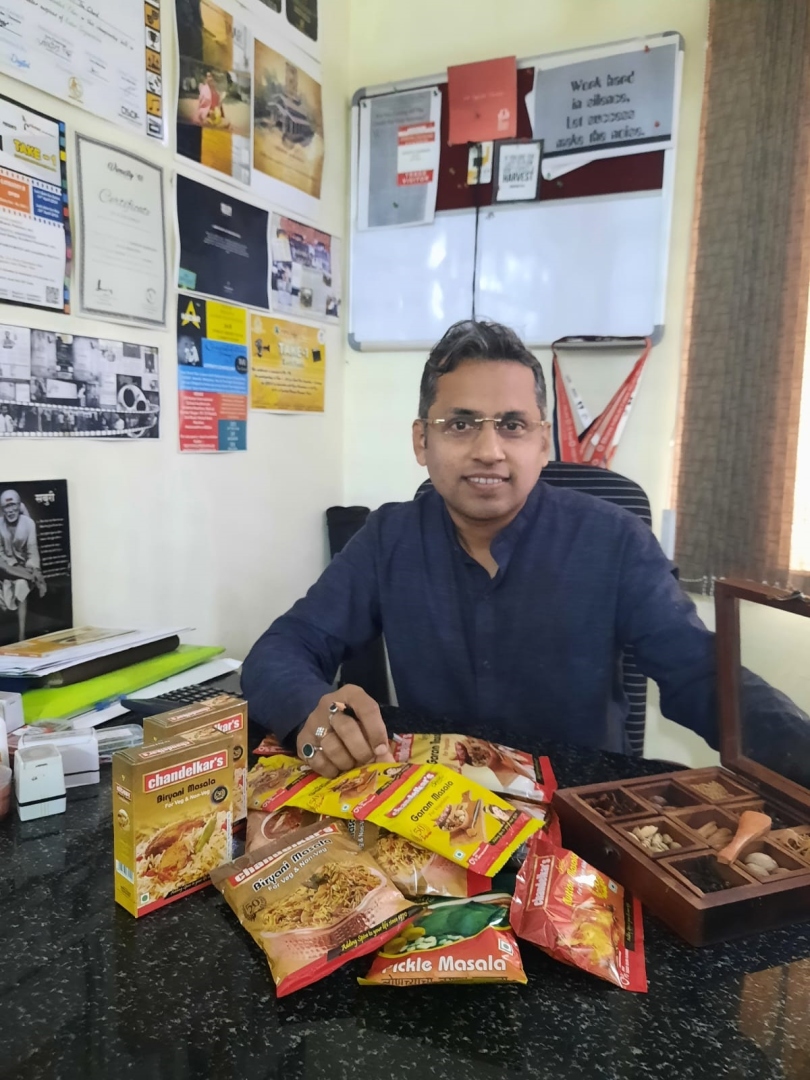A mechanical engineer, businessman, philanthropist and a passionate filmmaker, Gopinath Chandelkar heads the popular Goan brand of blended spices ‘Chandelkar’s’ taking the family legacy one step forward by aiming different markets

It’s a unique combination of ‘masalas’ that is typically Goan in nature. Started in 1970 by late freedom fighter Gopinath Chandelkar. ‘Chandelkar’s’ is a brand name familiar in most kitchens in Goa. Specialising in spices, the brand penetrated every home across the State and even gained popularity among the Goans living abroad. Over the years the business was taken forward by Gopinath's sons, and now his 44-year-old grandson (also named Gopinath Chandelkar) is taking the legacy ahead, heading the Blended Spices division at 'Chandelkar’s'. Named after his grandfather, Gopinath (alias Saish) is the owner and managing director of the manufacturing firm Vaishali Foods.
Gopinath is also the founder and chairman of Revas Universal Industries. This is a unit under the Revas Group responsible for marketing of ‘Chandelkar’s’ spices. Founded and incorporated in May 2018 as a trading firm, it deals mainly with spices and other food related products to cater to the domestic market as well as probable export market. “An arm of Révas Group, it is dedicated to trading blended spices and specialises in bringing the best and most pure spices to the kitchen. It is a one-stop destination for the spice needs of the market and we are gearing up the process for exports too now,” adds Gopinath.
Late Gopinath Chandelkar’s youngest son, Mohan Chandelkar also continues the responsibility of marketing the products in specific regions of Goa under his proprietary firm. The spices brand is gearing up the process for expansions in other areas now. “We manufacture primarily five products, pickle masala, mutton masala, garam masala, xacuti masala and biryani masala offering them in 15 different packaging sizes ranging from a kilo to 20 grams. We deal with blended spices that are prepared using 20 to 25 different ingredients in different combinations,” shares Gopinath who has been keen in research and development of blended spices since 2001.
“It’s been more than two decades that I am handling the spices section and our R&D lab is continuously working towards enhancing our brand speciality, maintaining the same quality. As any product, with time, needs improvement in the system of manufacturing process to stand tall in the market, we have focussed on experimenting with the spices,” explains Gopinath.
Naming the main ingredients, he adds, “In Goa, we prefer to use specific types of chillies for certain recipes to retain the typical taste. The chillies produced in Goa have different tastes, depending upon the village where they are grown – Harmal, Khola, Mapusa etc. Apart from local chillies, we also use Bedagi, Guntur, Lavangi, Kashmiri varieties for their colour, taste or pungent properties.”
A certified trainer from CFTRI, Mysore that offers scientific and systematic study of the botanical properties and medicinal usage of the spices, Gopinath agrees that this specialised study helped him in learning various compositions that take care of combinations. One has to maintain the quality and consistency in taste to satisfy each and every customer, and for that keeping the R&D process on is a must, feels Gopinath.
“The products are standardised after the R & D process, and are lab tested. We follow the latest FSSAI rules and do systematic production, aiming to bring quality products to the market. If one wants to retain a place in market competition, no compromise with quality should be allowed,” he believes.
“There are seasons where a particular spice has more demand in the market – e.g. in Shravan, when vegetarian food rules the month, demand for Garam Masala soars. From January to May, Pickle Masala is in demand, From October to December, Mutton Masala sales surge, while in the Mushroom season, customers prefer Xacuti Masala. Our spices are suitable for Chaturmas (four months) and for Jain foods as none of our products contain onion/garlic," says Gopinath.
Apart from chillies, Indians use various spices, including coriander, cumin, cloves, cinnamon, cardamom, carom seeds, caraway, nutmeg, star anise, fenugreek, fennel, pepper, poppy seeds, turmeric, tamal patra (dried leaves of Cinnamomum Tamala), mace, triphala, sesame, shahjeera, pudina, curry leaves, ginger, tamarind, amchur, asafoetida, sola (kokum), garlic, mustard seeds and even lime for taste enhancement. Barring few of these spices, Chandelkar’s blended spices use most of them.
“I want to mention that we don’t use onion and garlic in any of our combinations, hence our spices can be safely used in temples, or festivals like Ganesh Chaturthi and while celebrating sacred occasions like puja or havan where the usage of these two spices is not advised,” shares Gopinath.
Spices bring taste to the recipe. It also adds colour, flavour and aroma. Indians are known for their love of different spices for taste enhancement. Many of the spices have medicinal properties too, and their use in everyday food helps to keep in control many ailments. Understanding the concept well, Gopinath is planning to take the business to the next level, and begin exporting to different countries.
For export, observing elaborate regulatory measures and following specific packaging rules is must among other requirements. One also has to study the weather conditions abroad and whether it may have any impact on the taste of the spice. “Currently, the process is in the pipeline and soon we would begin exporting ‘Chandelkar’s’ spices,” quips Gopinath who has not restricted himself in only running or expanding his family business, but is also involved in philanthropic activities and following his passion of filmmaking, under Révas Foundation, Révas EduCare and Révas Productions respectively.